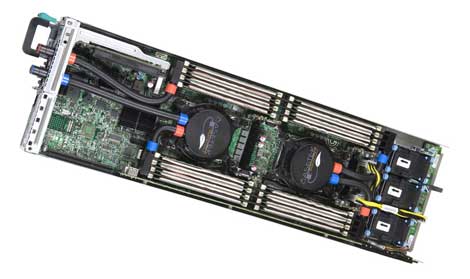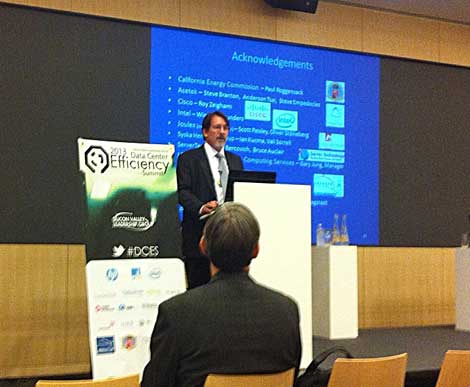
A server tray using Asetek's Rack CDU Liquid Cooling system, which was the focus of research discussed at the SVLG Data Center Efficiency Summit. The piping system connects to a cooling distribution unit. (Source: Asetek)
PALO ALTO, Calif. - Liquid-cooled servers at a data center at the Lawrence Berkeley National Laboratory used less energy in certain circumstances than air-cooled servers on site, a lab researcher said Tuesday at the sixth annual Data Center Efficiency Summit hosted by the Silicon Valley Leadership Group (SVLG).
The tests evaluated at Asetek's RackCDU low-pressure hot-water CPU and memory cooling technology connected to 38 Cisco servers in a rack at the data center. The servers' power use was compared with that of more traditional air-cooled servers, said Henry Coles, who works on infrastructure cooling systems at the Lawrence Berkeley lab.
The researchers tested for energy consumption with idle server loads, 50 percent server loads and 100 percent server loads. In most of the tests for full server loads, Coles said, the water from cooling captured more than half of the servers' heat.
Coles and his team used modeling software to project how much energy the system would use if implemented at a larger scale.
"This direct cooling technology should provide a significant reduction in total data center energy used," he said. He estimated a 16 to 20 percent energy reduction for a server load of 50 percent.
The research also indicated that, given the climate conditions of the modeling, using colder water when it's economically feasible would translate to lower energy consumption. Different climates might yield different results, though, Coles said.
High-Density or Lower Energy Use?
Liquid cooling has typically been used as a tool for handling high-density server installations, which generate more heat and thus are harder to manage using standard air cooling techniques. Water is significantly more efficient than air as a medium for heat removal. There are tradeoffs in using liquid cooling, however, including the cost of the equipment. If liquid cooling can reduce power usage, it could change the economics of purchasing different types of equipment.
An audience member asked about return on investment for the liquid-cooling equipment, and Coles had no clear answers.
"That's harder to do than this (energy modeling)," he said. "You get more opinions."
While liquid cooling has been deployed in supercomputing facilities and evaluated by webscale companies, it has started to make inroads inside more traditional data centers as well.
Asetek is certainly going after that market segment, and publicly available data on total cost of ownership with its equipment could boost the gear's appeal. The company was showing Cisco, Cray and Hewlett-Packard prototype servers packed with hot-water cooling systems at its exhibition booth, and it has previously shown a similar configuration with a Fujitsu server.
Indeed, commercially available products from such original-equipment manufacturers could increase adoption of liquid cooling, Coles said after his presentation.

Henry Coles, a researcher at Lawrence Berkeley National Lab, discusses his research on liquid cooling and energy efficiency at Tuesday's Data Center Efficiency Summit in Palo Alto, Calif. (Photo: Jordan Novet)




